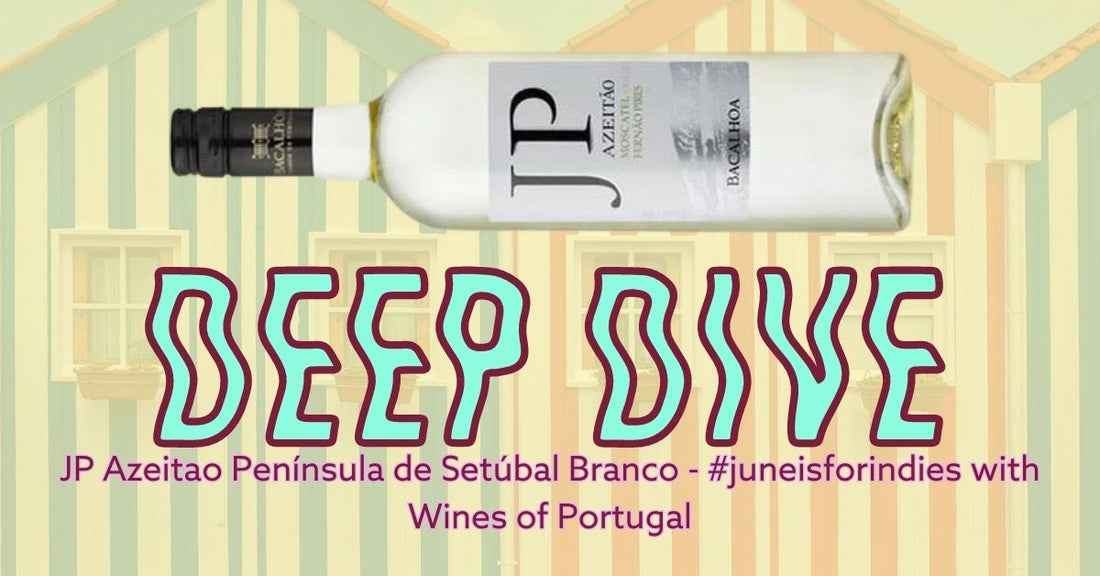Let's do another deep dive into our final white wine of the #juneisforindies Wines of Portugal contenders. We're having a wee look at JP Bacalhoa Azeitão Branco.
Region:
The Setúbal Peninsula is a wine region located in southern Portugal, just across the water from the country's capital, Lisbon. It is estimated that the vine culture in the region was introduced by the Tartessos, the first western civilization, around 2000 BC., which used the wine they produced in commercial transactions with others, an indication of how far back the vineyard culture dates in Setúbal.
Terroir:
Setubal is surrounded by the Atlantic Ocean and the Tejo and Sado rivers. The climate is temperate Mediterranean, with hot, dry summers and mild but rainy winters. The region is characterized by its abundant nature, clearly visible in places such as the Arrábida Natural Park, the D. Luís Saldanha Marine Park or the Sado Estuary Natural Reserve and also by its built heritage, equally great in diversity and historical value. The symbiosis between the climate and the soil of this region creates the perfect conditions for the production of high quality grapes.
Grapes:
It is known for its sweet and fortified wines, made mostly using the Muscat grape. When the Muscat makes up more than 85% of the wine blend, it can then be labelled a Moscatel de Setúbal. This wine is made up of Fernão Pires (fer-NOW pea-rezsh), Moscatel de Setúbal (mosh-ka-Tew deux seh-TU-baow)
How it tastes:
This is a lively fruity wine with a delicate floral characteristic. Fresh in the mouth with rich fruit aroma and a pleasant dry finish.
What to pair it with:
The local cheese!
Quaijo de Azeitão is a cheese that is made only in the Setubal wine region. The production of Quaijo de Azeitão in the Setubal region dates back to the 19th century. This local cheese is semi-soft and is made from sheep milk that is unpasteurized. The milk that is used in making the cheese is taken only from sheep that graze on the natural vegetation of the region.
The local fish!
Choco Frito is the most famous local dish of the Setubal Peninsula. The name of the dish sounds like it might contain chocolate, but it is in fact fried cuttlefish. Once fried, the cuttlefish are normally served drizzled with lemon and accompanied by fries, salad or potato chips.
The local dessert!
The name Farinha Torrada means toasted flour. This traditional dessert of the Setubal wine region has a long and interesting history. The treat originated from the need to make a delicious dessert that would last long and be nutritious so that fishermen could take them to sea. Farinha Torrada is made of eggs, sugar, and flour. These ingredients are combined to form a dough that can also be flavoured with cinnamon, lemon, and chocolate. Once the Farinha Torrada is cooked, it is normally served cut in a square. This local treat is so important to the Setubal region that it has even been registered by the local city council.
The local cheese!
Quaijo de Azeitão is a cheese that is made only in the Setubal wine region. The production of Quaijo de Azeitão in the Setubal region dates back to the 19th century. This local cheese is semi-soft and is made from sheep milk that is unpasteurized. The milk that is used in making the cheese is taken only from sheep that graze on the natural vegetation of the region.
The local fish!
Choco Frito is the most famous local dish of the Setubal Peninsula. The name of the dish sounds like it might contain chocolate, but it is in fact fried cuttlefish. Once fried, the cuttlefish are normally served drizzled with lemon and accompanied by fries, salad or potato chips.
The local dessert!
The name Farinha Torrada means toasted flour. This traditional dessert of the Setubal wine region has a long and interesting history. The treat originated from the need to make a delicious dessert that would last long and be nutritious so that fishermen could take them to sea. Farinha Torrada is made of eggs, sugar, and flour. These ingredients are combined to form a dough that can also be flavoured with cinnamon, lemon, and chocolate. Once the Farinha Torrada is cooked, it is normally served cut in a square. This local treat is so important to the Setubal region that it has even been registered by the local city council.
So try something a little bit different this summer - it's not all white Douros and Vinho Verdes!


